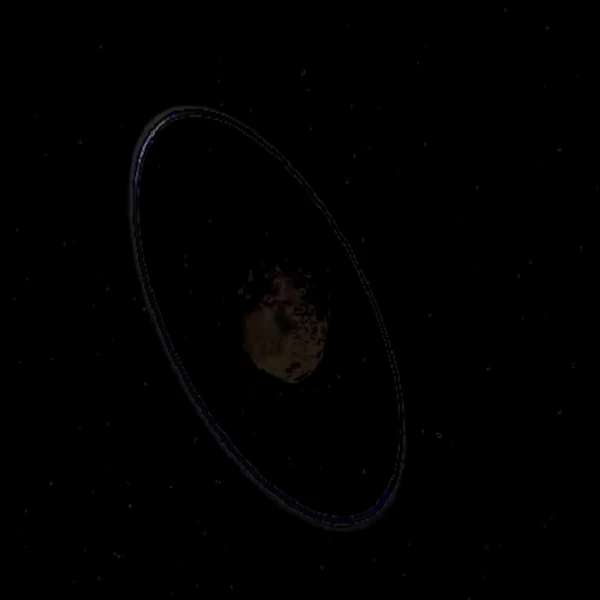
(10199) Chariklo is a centaur, approximately 250 km in diameter, notable for its ring system. Chariklo is located between two families of objects: the main belt asteroids (near Mars and Jupiter) and the trans-Neptunian objects of the Kuiper Belt. This intermediate position reflects the hybrid and unstable nature of this celestial body.
N.B.:
In Greek mythology, centaurs are half-human, half-horse creatures, situated between two worlds.
On June 3, 2013, astronomers observing a stellar occultation noticed two brief and regular drops in brightness before and after the main occultation. These signals revealed two distinct rings around the asteroid Chariklo, located between Saturn and Uranus. This is the first confirmed case of a ringed asteroid.
The rings, named C1R and C2R, are located approximately 391 km and 405 km from Chariklo's center, respectively. They are very narrow (5 to 7 km wide) but relatively opaque, suggesting a high density of particles. The total mass of the system is estimated to be negligible compared to Chariklo, but the dynamics remain stabilized by subtle gravitational effects.
| Ring | Mean radius (km) | Width (km) | Optical depth | Comment |
|---|---|---|---|---|
| C1R | 391 | 6-7 | 0.4 - 0.6 | Main ring, dense and relatively opaque (~1), comparable to the dense divisions of Saturn's rings. |
| C2R | 405 | 2-3 | 0.06 | Much fainter ring (<0.1), probably composed of fine and sparse particles. |
Source: Braga-Ribas et al. (2014), Nature 508, 72–75. DOI: 10.1038/nature13155
Several scenarios are considered to explain the origin of these rings: collision of a small satellite, fragmentation of a captured body, or remnants of ice and dust confined by possible shepherd moons. The Roche limit and the effects of Chariklo's orbital precession play a decisive role in their maintenance.
In the main belt, asteroids with truly stable rings are very rare. The rarity is explained by the higher gravity of main belt asteroids, which makes it difficult to form and maintain thin rings, and by the frequency of collisions that quickly destroy such systems.
Centaurs are a class of asteroids and small icy bodies located between the orbits of Jupiter and Neptune. Discovered from the 1970s onwards, they represent an intermediate population between Kuiper Belt objects and short-period comets.
Their dynamics are strongly perturbed by the giant planets, leading to unstable orbits with typical lifetimes of only a few million years. Centaurs are therefore considered transitional bodies: during their evolution, they can be ejected from the solar system, collide with a planet, or become active comets through the sublimation of volatile ices.
| Name | Number | Approximate diameter (km) | Discovery | Particularity |
|---|---|---|---|---|
| Chariklo | (10199) | 250 | 1997 | First known asteroid with a ring system |
| Chiron | (2060) | 220 | 1977 | Shows intermittent cometary activity |
| Pholus | (5145) | 190 | 1992 | Very red surface, rich in complex organic compounds |
| Asbolus | (8405) | 85 | 1995 | Dark surface, probably irradiated by the Sun |
| Bienor | (54598) | 200 | 2000 | Elongated shape, rapid rotation, possible surface activity |
| Elatus | (31824) | 70 | 1999 | Dark surface, neutral coloration, eccentric orbit |
| Okyrhoe | (52872) | 40 | 1998 | Partially red surface, slight cometary activity observed |
| Hylonome | (10370) | 70 | 1995 | Rapid rotation, low albedo, close to Neptune at aphelion |
| Echeclus | (60558) | 84 | 2000 | Active comet observed in 2000, dark surface |
| Thereus | (32532) | 60 | 2001 | Relatively neutral surface, low activity, eccentric orbit |
Sources: Jewitt (2009), Annual Review of Astronomy and Astrophysics 47: 441-478; Braga-Ribas et al. (2014), Nature 508, 72–75.